Entering the sixth room of the Museo Civico di Palazzo Corboli in Asciano, also known as the Aristotle Room, we can encounter, frescoed on the walls, some bizarre and unusual wheels filled with figures and episodes. These are works attributed to the inspiration of two fourteenth-century Sienese painters, Cristoforo di Bindoccio (Siena, documented 1361 to 1407) and Meo di Pero (Siena, documented 1370 to 1407), who were workshop mates and produced several undertakings together. The attribution to the two colleagues of the frescoes of Asciano is a recent fact: the first to refer them to their hand was the art historian Alessandro Bagnoli, who noted stylistic affinities with the frescoes in the chapel of the Spedale di Santa Maria della Scala in Siena and with the Stories of the Virgin in the church of Santa Maria in Campagnatico: these are both cycles whose dates we know exactly (1370 for the Sienese frescoes, 1393 for those in Campagnatico), and the freshness of the Asciano paintings would allow their temporal location to be situated close to the Santa Maria della Scala cycle. Moreover, a dating that appears entirely compatible with the acquisition by the inhabitants of Asciano of the citizenship of Siena, which was granted to them by the Republic in 1369.
Of the wheels we see on the walls, the one that most attracts our interest is the best preserved, which stands, solitary, on the northeast wall, the shortest. It is composed, in turn, of nine wheels: a larger one in the center, and eight surrounding it in the guise of a crown, each decorated with a story and accompanied by an explanatory inscription, like a caption. In the center we find a very rare figuration taken from the legend of Barlaam, a Christian retelling of the Buddha myth, which found a fortunate spread in medieval Europe: the protagonist is the Indian prince Iosafat (or Ioasaf: other is none other than the Siddhārtha Gautama of the Buddhist tradition) who, having grown up among worldly pleasures in the palace of his father, King Abenner, and kept away from the evils of the world in order to prevent him from knowing them, one day came across a blind man, a leper, an old man and a corpse, and thus understood that the world was quite different from how he had known it, and that existence could also be full of pain. Iosafat then met a Christian hermit, Barlaam: through the sage’s teachings, Iosafat decided to convert and abandon worldly things and instead devote himself to an ascetic life of meditation. Abenner tried in vain to persuade him to retrace his steps, but Iosafat even succeeded in converting his father: after the latter’s death, and having thus inherited the kingdom, Iosafat renounced it, preferring to continue his ascetic life together with Barlaam.
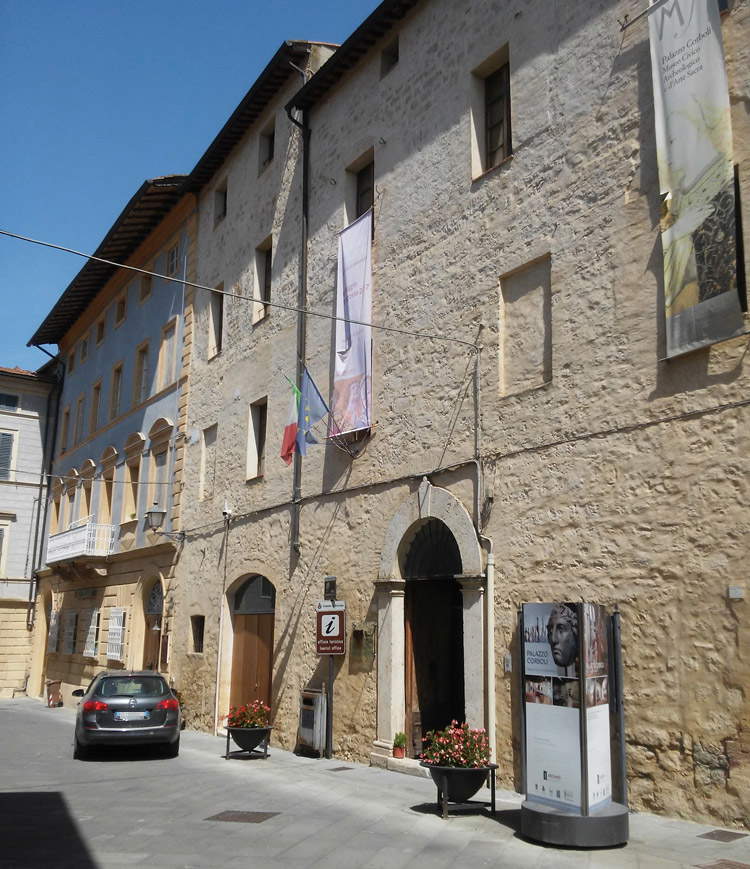 |
| Asciano, the facade of the Museo Civico di Palazzo Corboli |
 |
| The wall with Barlaam’s wheel |
 |
| Cristoforo di Bindoccio and Meo di Pero, Wheel of Barlaam (c. 1370; fresco, Asciano, Museo Civico di Palazzo Corboli) |
Since the nineteenth century, attempts have been made to reconstruct how the myth came to Europe from the East, but the genesis of the successful medieval novel has found order thanks to recent studies by philologist Robert Volk, which were widely echoed in Italy in the 2012 edition of The Story of Barlaam and Ioasaf edited by Silvia Ronchey and Paolo Cesaretti. The Buddhist tale arrived in Europe through Islamic mediation: in the 10th century, the Shiite theologian Ibn Bābūya al-Qummī composed his kitāb Kamāl-ad-dīn (“book of the perfection of religion”), and another book, the kitāb Bilawhar wa Būdāsaf (“book of Bilawhar and Būdāsaf”), in which the stories of a prince who met a hermit from whom he received teachings were told. Both were works that derived from earlier narratives of Persian origin, and on which, in turn, depended a translation into Georgian length, the Balavariani, a book that acted as a link between East and West and in fact initiated the “Christianized versions” of the story: the work, in turn, would be translated into Greek by a monk from Mount Athos, Euthymius the Georgian (Georgia, 955 - Mount Athos, 1028). The Greek translation sanctioned the beginning of the great spread throughout Europe: a so-called Latin “Vulgate” made its appearance in the twelfth century, and from the latter originated the various translations into the vernacular languages, as well as further Latin versions. In Italy, the dissemination of the Buddhist myth is mainly due to two works, the Speculum historiale of Vincent of Be auvais (Beauvais?, c. 1190 - 1264) and the Legenda aurea of Jacopo da Varazze (Varazze, 1228 - Genoa, 1298): both authors included the tale of Barlaam and Iosafat in their texts. The very names of the two protagonists refer to the Buddhist origin of the myth: “Iosafat” comes from the Arabic adaptation (“Būdāsaf”) of the Sanskrit appellation bodhisattva (in Buddhism, it is the human being who aspires to “bodhi,” spiritual enlightenment, i.e., the end of the religious path), while “Barlaam” is the “translation” of the Arabic Bilawahr (also attested as “Balawahr” later to become the Georgian “Balavari”), although in the latter case the transformation to “Barlaam” is somewhat more complex, as many note how the form “Barlaam” was also influenced by some confusion with a fourth-century martyr saint, Saint Barula (“Barlaha” in some languages). In any case, the root would be found in the adjective “Bhagavān” (“the glorious,” “the venerable”), an epithet of the Buddha.
The legend of Barlaam and Iosafat later ended up entering artists’ works as well: that of Asciano is the most complex figuration since it accommodates, the only case of which we are aware, several scenes in support of the fresco’s “thesis,” represented by Barlaam’s famous parable, theunicorn apologue, which occupies the central wheel of the Asciano fresco and which we find in other works even earlier ones (in one of the lunettes of the Baptistery of Parma, by Benedetto Antelami, in a fresco in the Cistercian abbey of the Tre Fontane in Rome that can be placed between the 13th and 14th centuries, and again in a 14th-century relief in Ferrara Cathedral and in a further relief on the portal of the chapel of Sant’Isidoro in San Marco in Venice). The tale tells of a man being chased by a wild unicorn, to the point that he was in danger of falling into a precipice if he did not cling to a tree. The unicorn’s danger seems averted, but there are two rats, one white and one black, gnawing at the base of the tree, there are snakes preventing the man from getting down to the ground, and most importantly at the bottom of the ravine there is a menacing dragon waiting ravenously for the hapless man. However, the man finds on one of the branches of the tree a honeycomb of honey, and he decides to stop worrying about the unicorn, the mice, the snakes, and the dragon. The apologue has given rise to a variety of interpretations: we give an account of that of the philologist and orientalist Max Müller (Dessau, 1823 - Oxford, 1900), according to whom the unicorn (an element introduced, moreover, in the translation of Euthymius: in Indian versions, the danger is an elephant) represents death, the tree represents life, the mice represent day (the white one) and night (the black one) and their act of consuming the tree the passage of time, the snakes are the elements of which the human body is composed, the dragon the underworld and the honeycomb the ephemeral pleasures of existence. In medieval art, the apologue takes on the task of demonstrating the fleeting nature of life and the vanity of worldly passions: such is the interpretation of Jacopo da Varazze, according to whom man, instead of worrying about salvation, becomes entangled in frivolities that will cause his perdition. Cristoforo di Bindoccio and Meo di Pero, in the Asciano fresco, keep rather faithful to tradition: the unicorn and the dragon, as in several other representations, are arranged on either side of the tree. Immediately below them we see the mice that have already gnawed much of the stem of the plant, while the man is standing in the crown in the act of grabbing the honeycomb of honey. The interesting aspect of the Asciano wheel is that every single detail is interpreted: thus, next to the mice we find the inscriptions Die and Night, then on either side of the tree, to indicate the man, here is the caption Quilibet h(ab)et in mu(n)do (“Whoever dwells in the world,” where the world, for the authors of the fresco, is represented by the tree) and finally, to illustrate the entire scene, the epigraph Hic est omnis homo decieptus ab arbore mundo (“This is every man deceived by the tree of the world”).
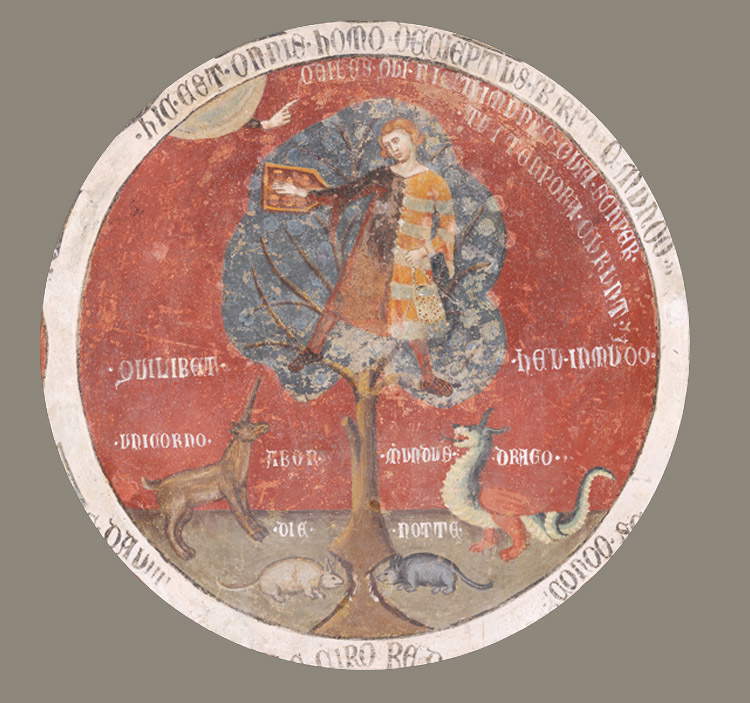 |
| The unicorn apologue |
As to how this legend could have come to Asciano, it is quickly said: in the mystical Siena of St. Catherine’s time, the story of Barlaam and Iosafat was so successful that St. Catherine’s secretary himself, the man of letters Neri di Landoccio Pagliaresi (Siena, c. 1350 - 1406), who moreover also had some assignments in Asciano, composed an adaptation of it in verse. Instead, to understand why it is on one of the walls of Palazzo Corboli requires some clarification about the building, which now retains the name of one of the families that owned it, but was actually built in the 13th century by the powerful Bandinelli family. For a certain period of time in the next century, that is, at the time when Asciano was part of the Republic of Siena (under which the fief passed in 1285), the building held public functions: it was probably in this palace that the ancient administration of the city was based, and the frescoes that decorated its walls were intended to guide the citizens. The ultimate goal was to spur the local community to pursue the common good: this is the message that all the frescoes in Palazzo Corboli imply, and the Wheel of Barlaam, with its clear call to cultivate virtue and let go of vices, is entirely in keeping with the purpose. Barlaam’s Wheel, moreover, would also be the only known case in which the scene finds space within a building intended for public use: the other figurations that we know of, in fact, were all made for churches or sacred buildings. A detail, this, that contributes to the work’s value and importance.
Continuing the reading of the fresco, in the eight wheels that accompany the one with the parable of the unicorn, we find as many stories that refer to inglorious deaths of kings and notable figures of antiquity, as if to emphasize that perdition does not spare even those on earth who have reached the highest ranks of power. The protagonist of the highest roundel is Nero, identified by the inscription “Nero,” who kills himself with a sword (the emperor had in fact lost the support of the Senate, which deposed him). Moving forward clockwise, we immediately find the least legible of the wheels: in all likelihood it is the death of Pompey (the lacunose inscription “peio” may be the final part of his name), killed on a boat by two assassins sent by Ptolemy, king of Egypt, who wanted to ingratiate himself with Caesar by eliminating his rival, but actually achieved the opposite effect. Here, then, is the wheel of"Priam king of Troy father of E(ttore),“ who is about to be killed by Pyrrhus during the agitated final stages of the Trojan War. The fourth wheel is that of ”el secondo Scipione Africhano de Cornelli": it is Scipio Aemilianus who is murdered while sleeping. The lowest wheel is that of "el grande Ciro re di Persia," as he is about to be beheaded at the behest of Tomiri, queen of the Massageti who had defeated the Persians in battle. In the sixth wheel we see Absalom, “(A)s(al)one fili(uolo) de re Davit,” being killed with three spears by Joab, general of King David’s army, because he had attempted to usurp his father’s throne. The seventh wheel recounts the death of Agamemnon, murdered upon his return from the Trojan War by his wife Clytemnestra with the help of the latter’s lover, Aegisthus. The eighth and final wheel is dedicated to Falarides, tyrant of Agrigento, who was famous for cruelty and ended up the victim of a conspiracy.
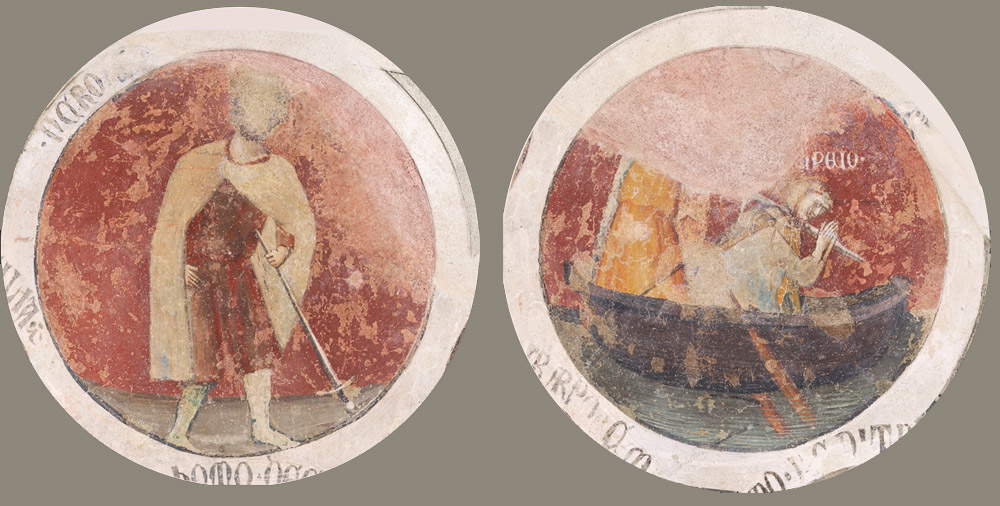 |
| The wheels of Nero and Pompey |
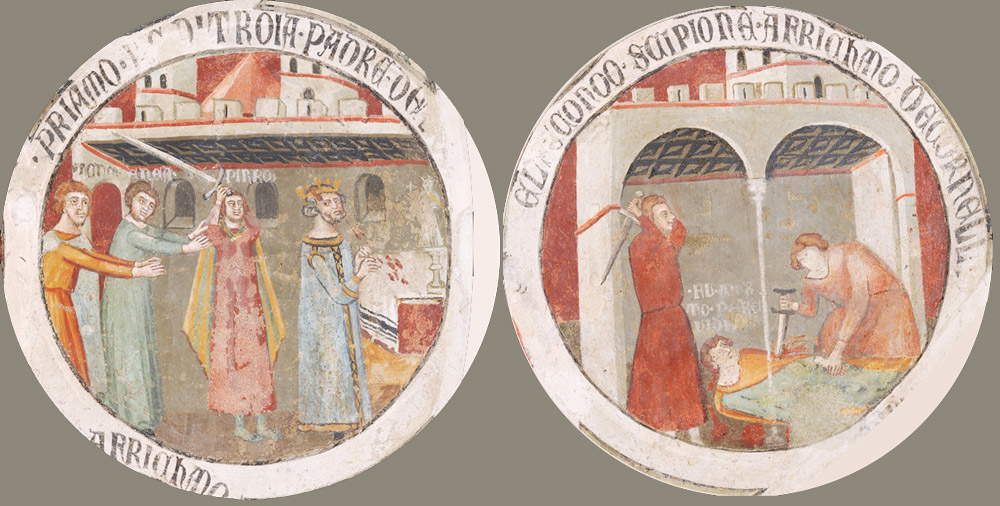 |
| The wheels of Priam and Scipio |
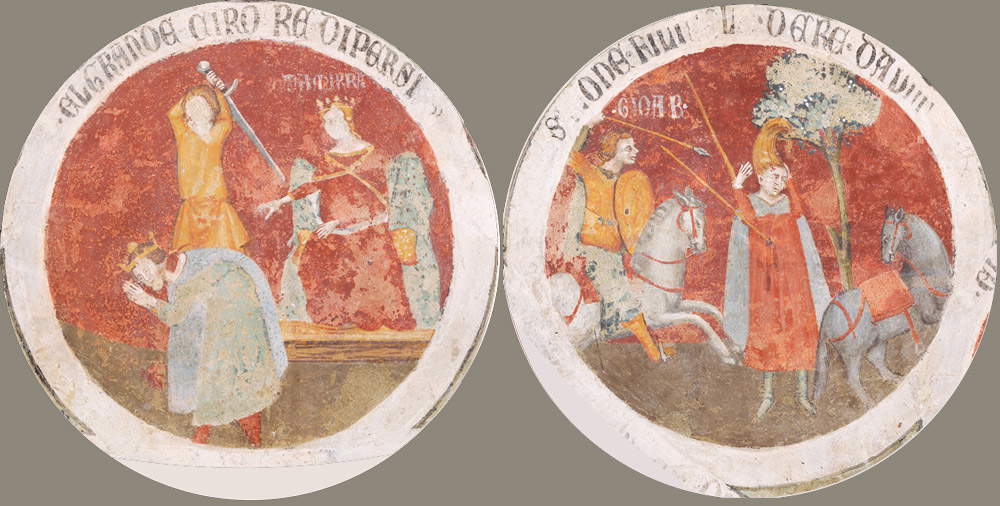 |
| The wheels of Cyrus and Absalom |
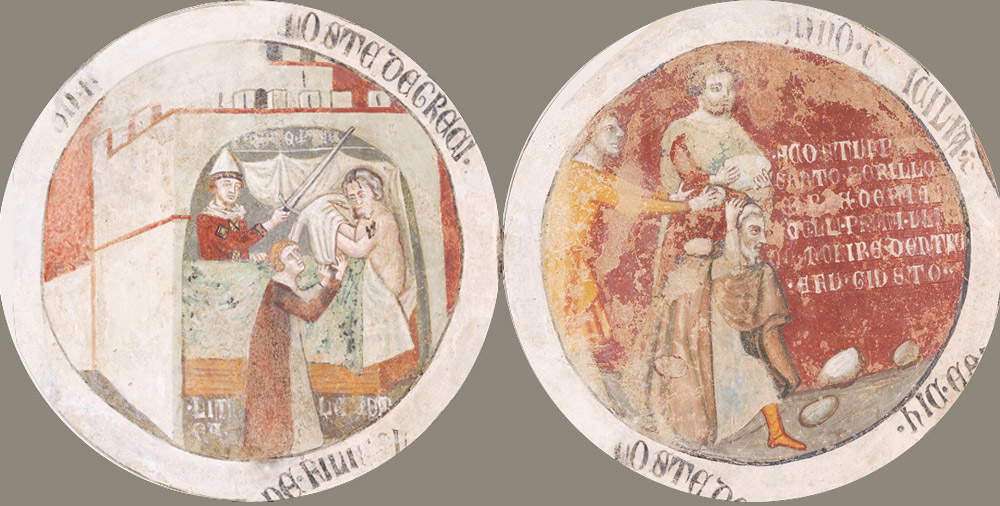 |
| The wheels of Agamemnon and Falarides |
The narrative conceptually follows the three wheels on the adjoining wall, which we find next to the door with jambs decorated with the Sienese balzana, the city’s black-and-white striped coat of arms. The first one we encounter depicts the dream of Nebuchadnezzar, who had dreamed of a great statue of gold, silver and bronze, of steel and clay: he had seen it rise only to fall felled by a stone. The dream, recounted in the book of the prophet Daniel, alluded to the fall of his kingdom and the coming of the kingdom of God. The second wheel features at its center the figure of the philosopher Aristotle, an example of virtue and personification of wisdom, who gives name to the whole room and “presents” the examples of the room: we see him in the central square, which in turn is in the center of a large square inscribed in the wheel and divided into nine sectors, alternating squares and quadrilobes. Unfortunately, the top three figures are damaged, but we can make out the others, although sometimes identification is not the easiest. At the bottom we have, on the sides, Fortitude and Temperance in the squares (the former with the attribute of the lion’s skin, symbol of strength, the latter mixing hot and cold water as per typical iconography) and in the center a figure that is difficult to read, which as well as the others in the quadrilobes should embody an example connected to one of the four virtues (we have to imagine that Prudence and Justice were in the upper register). Finally, in the last wheel, we find the judgment of Solomon. This is the famous biblical episode in which the wise king, in order to settle a dispute between two mothers who were contending for a child, ordered the child to be divided in half with a sword: the true mother, in order to see her child live, begged to give him to the other, so Solomon understood which of the two was the true mother and was able to give the child to the right woman.
A long and complex narrative, therefore, inviting the ascianesi of the 14th century, as mentioned above, to pursue the common good through the exercise of virtue and the abandonment of earthly passions: all embedded in the significant form of the wheel, which perhaps alluded to the ups and downs of fortunes decided by fortune. Intent not dissimilar to that of the frescoes of good and bad government that Ambrogio Lorenzetti (Siena, c. 1290 - 1348) had painted a few decades earlier in the Sala dei Nove in Siena’s Palazzo Pubblico and of which those in Asciano constitute a reprise: an in-depth study by the late art historian Maria Monica Donato states that in the undertaking of Cristoforo di Bindoccio and Meo di Pero we seem to read “the first known monumental quotations from the cycle that Ambrogio Lorenzetti stretched, in 1337-1340, on the walls of the Sala dei Nove.” There are several similarities noted by Maria Monica Donato, and to realize this it would be enough even to look at the figure of the protagonist of the unicorn apologue and compare him with the first knight of the fresco of the “effects of good government in the country,” of which he seems to be almost a quotation. This is not the only case, and these continuous references should support the hypothesis of a close dependence of the frescoes of Asciano on those of Siena, as part of a continuous program of educating citizens through images that the Republic of Siena carried on with constancy and perseverance.
 |
| The wall with the wheel of Aristotle |
 |
| Cristoforo di Bindoccio and Meo di Pero, Wheel of Aristotle (c. 1370; fresco, Asciano, Museo Civico di Palazzo Corboli) |
It is then worth noting the great cultural significance of the frescoes of Asciano, which, although they are the work of a peripheral village, nevertheless have much to share with the center, represented by Siena: suffice the example of the Wheel of Aristotle, which precedes by forty years the cycle of theAnticappella in the Palazzo Pubblico in Siena, painted in 1415 by Taddeo di Bartolo (Siena, c. 1362 - 1422), and which is based on an iconographic program that has several differences (suffice it to say that, in the more cultured Siena, the inscriptions are in Latin, as opposed to those in Asciano, which are mostly in the vernacular) but which is also aimed at celebrating the Virtues and Aristotle as a philosopher showing the way forward (indeed: the figure of Anticappella has many similarities with that of Asciano, beginning with the pose and the act of holding the scroll with moral warnings). Not being able to assume, according to Maria Monica Donato, that the paintings of the periphery had constituted a precedent for the center, also because of the diversity of the two cycles, it is nevertheless necessary to note how the substantial autonomy of the frescoes of Palazzo Corboli, in which the figure of Aristotle appears iconographically untied from the previous depictions of the philosopher and represents a further case more unique than rare, turns out to be “karst emergence of an authoritative obscured fourteenth-century tradition, which in Asciano is imagined echoed, in the Anticappella developed, updated, adapted to a changed climate and to the peculiarities of the structure of the locale.”
Add to this the extreme rarity of finding the legend of Barlaam and Iosafat painted on a wall (which in Italy we find frescoed only in two cases: here in Asciano, and in the aforementioned Tre Fontane Abbey in Rome), and above all of finding it included, together with the exempla with which it is accompanied, in an iconographic program of public utility addressed to the entire citizenry: an important unicum that has no other counterpart. Data that, alone, would be sufficient to exalt the uniqueness of these frescoes, among the most precious of the European fourteenth century.
Reference bibliography
Warning: the translation into English of the original Italian article was created using automatic tools. We undertake to review all articles, but we do not guarantee the total absence of inaccuracies in the translation due to the program. You can find the original by clicking on the ITA button. If you find any mistake,please contact us.